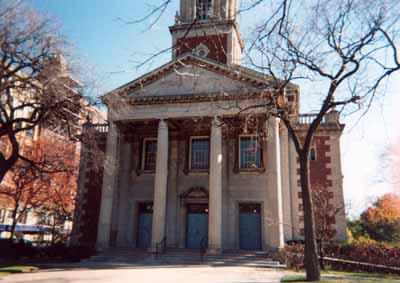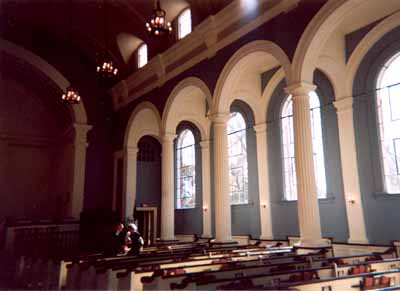 |
|

The church: First Congregational, Grove Street at Hinman, Evanston, Illinois.
Denomination: Technically, none (since it's purely congregational), but they are affiliated with a confederation of like churches called the National Association of Congregational Christian Churches (NACCC), headquartered in suburban Milwaukee. Most congregational churches in America joined with another group to form the United Church of Christ (UCC), but many that opted out are now with the NACCC. It took five years for the UCC to get off the ground (1957-1962), and I've been told there was a great deal of litigation over turf during that time. In other words, the legal doings were more over land rights than theology.
The building: Lots of people call this style "colonial revival," but as any architect can tell you there wasn't much during pre-revolutionary days to revive. The half-moon transoms suggest Christopher Wren, but there is a Greco-Roman portico, spiced up with Corinthian colums and filials. The exterior is brownish-orange brick. At first glance, the building looks like the sort of church Andy Hardy and his family would have attended. I'm also told that some of its design elements were borrowed from St Martin's-in-the-Fields, London.
The church: Evanston has a reputation of being a WASP enclave, and a snobbish one. That has worn away somewhat over the years as the town ceased to be exclusively white and different ethnic groups moved in. The people at First Congregational are stereotyped as the elite, so I wanted to witness the "Old Evanstonians" in their element, and before they die out.
The neighbourhood: The church sits at the apex of a greensward, the other two poles being First Presbyterian Church and Lake Street Church of Evanston (Northern Baptist). First Congregational is only a block or two from the downtown business district. And the closer one approaches Lake Michigan to the east, the wealthier the homes: from 1920's wrap-around porch affairs to real mansions right on the lake.
The cast: Thomas Miller, Senior Minister; Christine Meyer, Minister of Spiritual Formation and Christian Education; and (very good) organist David Lornson, Director of Music.
One service, 10.00am.
How full was the building?
One-third full, roughly. The loft is used by the choir only for its sung benediction. For an amateur choir, they are quite good – and they made up one-fifth of the whole congregation!
Did anyone welcome you personally?
Smile, handshake and bulletin from one of the ushers. There wasn't anyone in my pew, but then I chose an empty one lest anyone see me furiously taking notes. The church's "ritual of greeting" is similar to passing the peace.
Was your pew comfortable?
A little more comfortable than the ordinary. Good spacing between pews, and the nave has left, center and right aisles. This gave a nice feeling of spaciousness.
How would you describe the pre-service atmosphere?
On a scale of one to 10, with one being the bad part of Hieronymous Bosch's "Garden of Earthly Delights" and 10 being pin-dropping hush, I would rate it about an 8.5 to 9. Greeting, socializing, etc, took place in the narthex.
What were the exact opening words of the service?
"Come, holy and gracious God."
What books did the congregation use during the service?
In each pew rack, leading from right to left, "Hymns, Songs and spiritual Songs," which is simply the entire 1990 Presbyterian Hymnal with a generic cover, in this case maroon. Middle was the good old Pilgrim Hymnal from the 1950s, well worn but undoubtedly worth keeping, in dull red. On the left a bright red pew Bible. The three books taken as a whole were very nicely color-coordinated.
What musical instruments were played?
Organ. The organist was very good, and the choir was quite good for an amateur choir.
Did anything distract you?
If anything struck me as unusual, it was possibly that the congregation was too still and unemotional.
Was the worship stiff-upper-lip, happy clappy, or what?
The worship was very much mainline Protestant ca. 1975. I don't mean to be catty about that, as there were no dubious modern innovations such as spontaneous witnessing or anemic homemade call-and-response. I noticed that a few of us were singing the second line of the Doxology "Praise God all creatures here below," instead of the traditional "Praise Him all creatures here below." But only a few of us.

Exactly how long was the sermon?
17 minutes, and well worth it.
On a scale of 1-10, how good was the preacher?
7 – Well delivered, in spite of using notes. The first two-thirds was quite good, but I'm deducting a point from the rating because the climax of the service was sort of a mushy "Jesus is calling us to service." Many people believe that this non-controversial sentimentality about the Son of God is partly responsible for the mainline churches' decline over the past 30 years.
In a nutshell, what was the sermon
about?
He led with a metaphor from historian Barbara Tuchman's "The Proud Tower," about how Europe from 1910 to 1918 became not a continent but "a subjugation." He suggested that Christ's work should go on in spite of the constant media and commercial "noise" we are subjugated to. He ended with the wishy-washy "Jesus is your buddy" described above.
Which part of the service was like being in
heaven?
The interior of the church was magnificent – no stained glass but leaded transom windows, and painted in subtle (but obviously well thought-out) versions of the color blue: robin's egg blue, Carolina (or "Williamsburg") blue, powder blue. The effect was subtle but quite enchanting, especially as compared to the dull sunshine yellow so many Protestant churches have used to repaint. A mixed blessing: the congregation's tendency to coolness paid off in following the ritual. If you've ever seen all worshipers rise simultaneously to sing the doxology, you know what I mean.
And which part was like being in... er... the other place?
Technically, nothing went wrong except for one cranky baby swiftly removed, but I found the color-coordinated hymnals and Bible offputting. Is it possible to have too much design? Does it happen that a "status quo" atmosphere could make a sanctuary bland in an almost Hallmarkian way?
What happened when you hung around after the service looking lost?
I hung around through the postlude, wandered the sanctuary a bit, then asked someone if I could take flash pictures of the pulpit. That person said "yes," but did not offer an introduction. In the narthex, however, the minister was most welcoming and introduced me to a couple of the members.
How would you describe the after-service
coffee?
Quite good: coffee, tea and goodies including pistachio cake.
How would you feel about making this church your regular (where 10 = ecstatic, 0 = terminal)?
6 – The church has a lot to offer, but it may be "not my class, dear." In terms of program, I need to see how much "go" there is besides the "show." There were no African-Americans and only a couple of other nonwhites in attendance. The church has a few openly gay members but no gay/lesbian organization per se. Nonetheless, I intend to visit again. What is old-fashioned to one person may be charmingly traditional to another.
Did the service make you feel glad to be a
Christian?
Absolutely, and glad to be a Protestant too.
What one thing will you remember about all this in seven days' time?
The southern sunshine pouring through the Christopher Wren-type windows.
| The Mystery Worshipper is sponsored by surefish.co.uk, the internet service provider from Christian Aid. By offering email services, special offers with companies such as amazon.co.uk and smile.co.uk, surefish raises more than £300,000 a year for Christian Aid's work around the world. Click here to find out how to become a Mystery Worshipper. And click here if you would like to reproduce this report in your church magazine or website. Top | Other Reports | Become a Mystery Worshipper! © Ship of Fools 2001 |